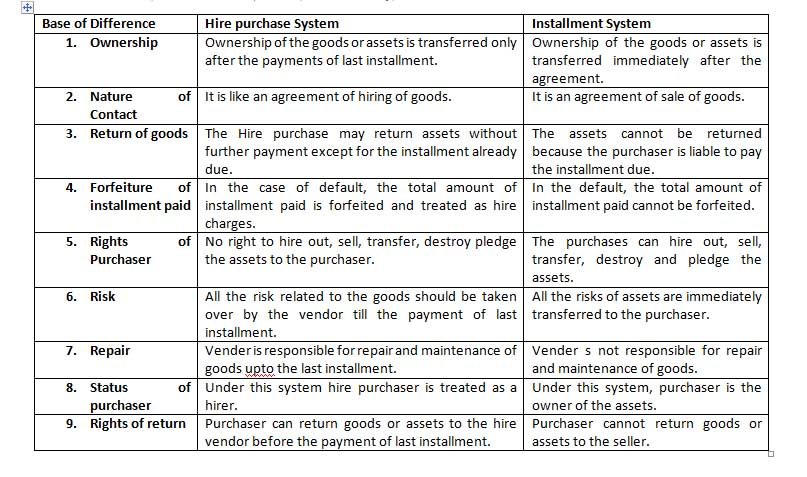Hire purchase is a method of financing of the fixed asset to be purchased on future date. Under this method of financing, the purchase price is paid in installments. Ownership of the asset is transferred after the payment of the last installment.
Features of Hire Purchase
The main features of hire purchase finance are:
- The hire purchaser becomes the owner of the asset after paying the last installment.
- Every installment is treated as hire charge for using the asset.
- Hire purchaser can use the asset right after making the agreement with the hire vendor.
- The hire vendor has the right to repossess the asset in case of difficulties in obtaining the payment of installment.
Advantages of Hire Purchase
Hire purchase as a source of finance has the following advantages:
- Financing of an asset through hire purchase is very easy.
- Hire purchaser becomes the owner of the asset in future.
- Hire purchaser gets the benefit of depreciation on asset hired by him/her.
- Hire purchasers also enjoy the tax benefit on the interest payable by them.
Disadvantages of Hire Purchase
Hire purchase financing suffers from following disadvantages:
- Hire purchase contracts are usually fixed, therefore if you find yourself in financial difficulty during that period, you may lose the asset and damage your credit rating.
- You’ll pay more for whatever it is you’re financing through hire purchase.
- You won’t own the asset until you have made the final hire purchase payment. Therefore the vendor has the right to seize it should you fall foul of their terms.
- Because you won’t own the asset, it won’t be protected if you’re made bankrupt. This is because it is technically still owned by the vendor during the agreement.
- The duration of most hire purchase schemes can be quite long anywhere between 3 to 5 years. If it’s for a car, that can make a lot of sense, but for other purchases you’ll need to consider if there really is a benefit in spreading the cost for that length of time.
- Hire purchase agreements aren’t free. As with all forms of financing, you’ll pay a fee for spreading the cost. Many hire purchase schemes can prove quite costly in that regard.
- Mind the gap! If you are buying an asset such as a car and it is stolen/ destroyed before it is fully paid for, the insurance may not cover the replacement value. This means you could face a shortfall. “Gap insurance” can be arranged to cover this situation but will add to your costs.
Installment Purchase
Some companies will sell you something that costs quite a bit of money and let you make an installment purchase. This kind of purchase lets you pay for the item in several future payments. You get to enjoy the item while you pay for it.
You might see an advertisement for a knife set where you pay just four payments of $59.95. Installment purchases can be simple like that knife set or they can be more complicated. That all depends on the kinds of terms involved. Some installment purchases will have interest included while others won’t.
Terms
The terms are the conditions of the installment purchase. They tell you what kinds of payments to expect and when you need to pay them. For the knife set, our terms are very simple. All we need to do is to make 4 monthly payments of $59.95 and we are done. There is no interest mentioned here. These are simple terms.
More complicated terms may have an interest payment involved. They might say that you need to make monthly payments for 5 years and also pay an annual interest of 5%. These more complicated terms are for much larger purchases, such as a car costing you $20,000.
Formula
Because there is an interest involved in our terms now, our monthly payment won’t be the cost of our car divided by the number of months. We also have to include the interest payment. Good thing for us math learners, we have a formula that allows us to calculate our fixed monthly:

Here, P stands for our fixed monthly payment, L stands for the cost of the item, r stands for the interest rate, and n the total number of payments. To use this formula, we plug in our values for L, r, and n to calculate our P.

3 thoughts on “Hire Purchase and Installment Purchase”